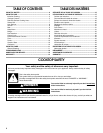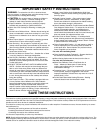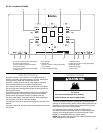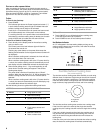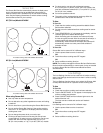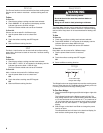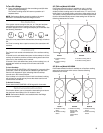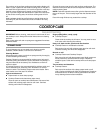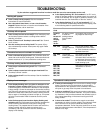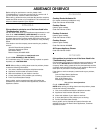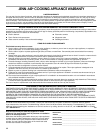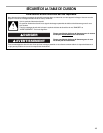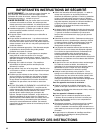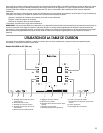
10
To Use:
1. Check that a surface cooking area has been selected.
2. Touch BOOST. “P” will appear in the display.
3. Touch BOOST keypad when finished. The “P” will no longer
be visible in the display, and the Performance boost function
will no longer be active. The surface cooking area turns back
to heat setting level 9.
NOTE: The Performance boost function may automatically
deactivate to keep the internal electronic components of the
cooktop from becoming too hot.
Timer
Use the cooking timer to set times up to 90 minutes. The timer is
independent of any other control settings. There is a separate
timer for each cooking zone.
To Use:
1. Select the desired cooking zone.
2. Touch the TIME keypad. “01” will appear in the timer display.
3. Touch the “>” key to increase the time in 1-minute
increments.
or
Touch the “<” key to decrease the time in 1-minute
increments.
4. The timer will start to count down after a few seconds.
To change the time, touch the time “>” or “<” keypads.
5. When the countdown is finished,”00” flashes and a tone will
sound.
NOTE: When the power is restored after an interruption, the timer
will no longer be running.
Tones
Tones are audible signals, indicating the following:
One tone
■ Valid pad press
■ Slider is moved to “0” power level
■ Slider is moved to “Boost” power level
Two tones
■ Invalid pad press
Three tones
■ End of Timer cycle
■ Boiling point is reached when using the Sensor Boil feature
Ceramic Glass
Cleaning off the induction cooktop before and after each use will
help keep it free from stains and provide the most even heating.
For more information, see “General Cleaning” section.
■ Avoid storing jars or cans above the cooktop. Dropping a
heavy or hard object onto the cooktop could crack the
cooktop.
■ To avoid damage to the cooktop, do not leave a hot lid on the
cooktop. As the cooktop cools, air can become trapped
between the lid and the cooktop, and the ceramic glass could
break when the lid is removed.
■ For foods containing sugar in any form, clean up all spills and
soils as soon as possible. Allow the cooktop to cool down
slightly. Then, while wearing oven mitts, remove the spills
while the surface is still warm. If sugary spills are allowed to
cool down, they can adhere to the cooktop and can cause
pitting and permanent marks.
■ To avoid scratches, do not slide cookware or bakeware
across the cooktop.
■ To avoid damage to the cooktop, do not allow objects that
could melt, such as plastic or aluminum foil, to touch any part
of the entire cooktop.
■ To avoid damage to the cooktop, do not use the cooktop as a
cutting board.
■ Use cookware about the same size as the surface cooking
area. Cookware should not extend more than ½" (1.3 cm)
outside the area.
■ Use flat-bottomed cookware for best heat conduction and
energy efficiency. Cookware with rounded, warped, ribbed or
dented bottoms could cause uneven heating and poor
cooking results.
■ Determine flatness by placing the straight edge of a ruler
across the bottom of the cookware. While you rotate the ruler,
no space or light should be visible between it and the
cookware.
■ Make sure the bottoms of pots and pans are clean and dry
before using them. Residue and water can leave deposits
when heated.
Cookware
Only ferromagnetic pans can be used for induction cooking.
Ferromagnetic materials include:
■ Enameled steel
■ Cast iron
■ Stainless steel designed for induction cooking
Non-ferromagnetic materials include:
These types of pans will not work with induction cooking.
■ Stainless steel
■ Glass
■ Ceramic
■ Copper or aluminum pans
To find out whether your pans can be used with an induction
cooktop, flip the pan over, hold a magnet to the bottom of the
pan, and see whether it sticks. If the magnet sticks to the bottom
of the pan, the pan is ferromagnetic and can be used for
induction cooking.
A.Surface cooking area
B.Cookware/canner
C.½" (1.3 cm) Maximum overhang
A
B
C



